Our 2010 Spring garden was faced with much adversity, in that, it was plagued with grasshoppers and overcome by drought. We had very few tomatoes to harvest over the entire Spring and Summer months. But thank the Lord for His graces and mercies: come Fall, the grasshoppers began to die out, cooler temperatures came, and God sent a couple of good rains. We were thrilled when we started to see flowers start to bloom and eventually grow fruit all over our six, overgrown, previously empty, tomato plants:
As Autumn progressed, we started to put blankets over the tomato plants but could tell they were probably not going to be able to ripen on the vine with the prevalent cooler weather patterns. I was able to harvest three large baskets of unripened tomatoes and put them in our summer kitchen building:
I knew they would rot if I left them as-is in the baskets, so I spread them out wherever I could find room. Here…….
Here……
And more here!
I checked on the tomatoes pretty much daily and grabbed the ripened ones to use in salads, sandwiches and other dishes. Man, there is nothing like the taste of a garden tomato! I had to keep a close eye on them because they can rot when you blink! And if they are touching in any way, it seems the rotting can be contagious. Our pigs ended up eating their share of rotten tomatoes, but at least they didn’t go to waste:
When I had a goodly amount of ripened tomatoes, I went ahead and preserved them by making some tomato-apple chutney. Yum! For anyone who is interested, here is the easy recipe from the Ball Blue Book of Preserving:
Tomato-Apple Chutney (yields about 6 pints, but you will probably yield more if you are generous with the ingredients)
2 1/2 quarts (about 12 large) chopped, peeled, cored tomatoes (I did not peel or core mine)
1 quart (about 5 medium) chopped, cored, peeled apples (I did not peel mine)
3 cups brown sugar
2 cups (about 1 large) chopped cucumber
1 1/2 cups (about 1 1/2 medium) chopped onions
1 1/2 cups (about 2 medium) chopped sweet red peppers
1 cup raisins
1 hot red pepper, finely chopped (I used a jalapeno pepper)
1 clove garlic, minced
1 tablespoon ginger
1 teaspoon salt
1 teaspoon cinnamon
3 cups vinegar (I used apple cider vinegar)
Combine all ingredients in a large sauce pot. Simmer until thick. Stir frequently to prevent sticking. Ladle hot chutney into hot jars, leaving 1/4-inch head space. Remove air bubbles. Adjust two-piece caps. Process 10 minutes in a boiling-water canner. (Be sure to check for any time or weight adjustments based on altitude)
(Recipe variation: For a milder chutney, remove seeds from hot pepper)
(Note: When cutting or seeding hot peppers, wear rubber gloves to prevent hands from being burned)
Here are all the ingredients combined and ready to be simmered:
And here it is after simmering, ready to be poured into clean, hot canning jars.
I have found chutney is really tasty with rice dishes, as a garnish or topping to meat or anything to which you want to add a sweet/sour savory tang or “pizazz.” I am thankful to have found these chutney recipes to assist in preserving many of our garden veggies and orchard fruits:
There came a point in the Winter where the rotting was increasing and the ripening was taking a long time, so I decided to attempt lactic fermentation with the remaining green tomatoes:
I combined the green tomatoes, chopped onion, chopped garlic and chopped green peppers (I think those are all the ingredients I used). You can put most any combination of garden veggies together for lactic fermentation:
I put it raw in canning pint jars, along with two teaspoons of canning salt in alternating layers, and filled the jars to within one inch head space with water. Then I put the tops on and……..that’s it! Lastly, I placed them down in the root cellar. Over the course of days to weeks, it develops that tangy fermented taste that is sooooooo good for your gut. It actually makes a great salsa, and we also put it on our salads.
We thank God for His perfect timing in providing this late tomato harvest and for His faithful provision:
Susan
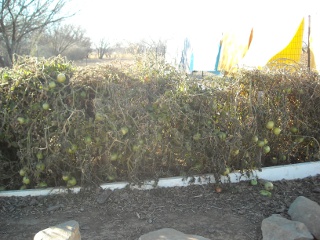
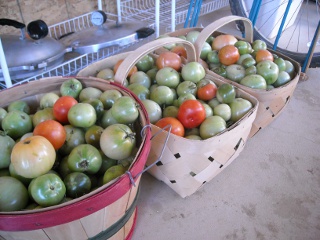
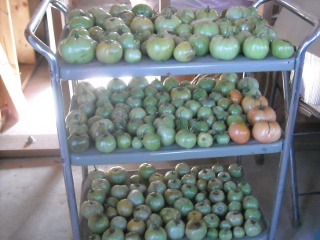
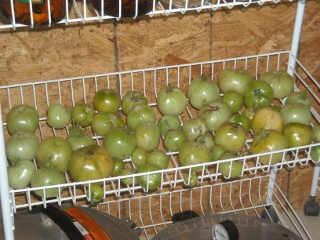
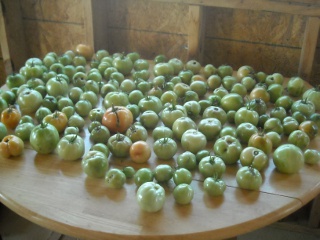
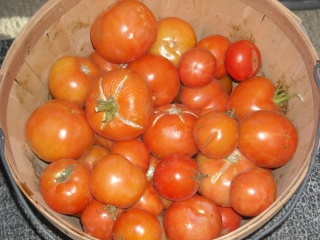
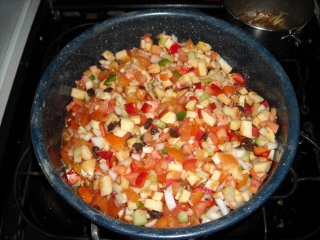
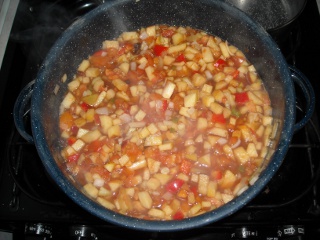
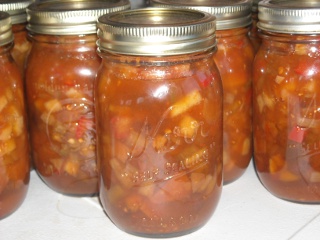
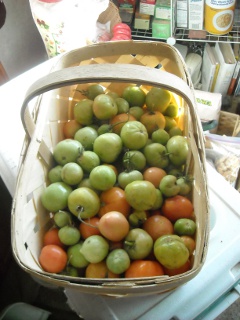
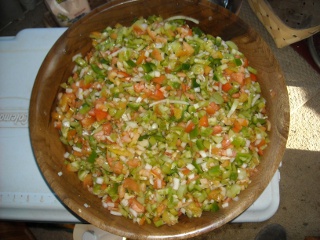
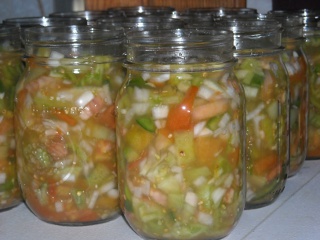
Isn't God's faithfulness and blessing amazing. I love the idea of lactic fermenting the tomatoes. I use my extra green tomatoes to make and can chile verde. David likes it cooked with pork, potatoes and sometimes hominy. He thought the lactic ferment method was a good idea as well and, Lord willing, we'll have some some tomatoes this year to try it. Thanks.
may I ask how much salt you would use in one jar? Is the final taste very salty? Thanks for sharing the recipes I have read about fermentation but never tried it Blessings Marie
Dear Mrs. Beekeeper: Yes, Amen, God's blessings and faithfulness are never ending. That chile verde sounds great! I'll have to look into making some of that myself. Thank you for writing and commenting!
Marie, I use two teaspoons of canning salt to each pint. I suppose you would double that if you were using quart jars. I alternate layers of salt and vegetables and then fill with water. The final taste is not salty, in my opinion, but really "tangy" like sauerkraut or dill pickles, depending on what vegetables you are fermenting. By itself, it is a strong flavor, but added to salads or other dishes, it makes a very nice compliment. The green-tomato salsa I talked about in the blog, along with the onion, garlic and green peppers, has a wonderful, robust, taste more like salsa. I hope you try lactic fermentation and find it very beneficial! Thank you for taking the time to write.
Susan